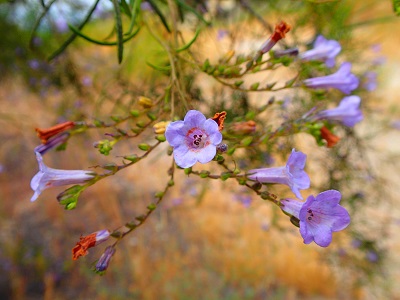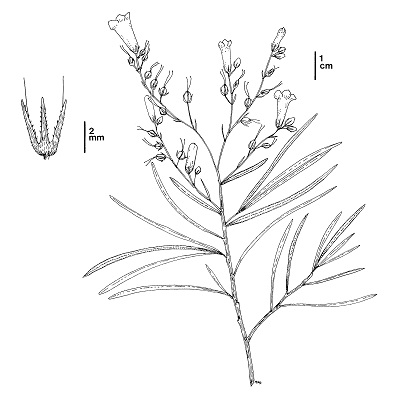(Eriodictyon altissimum)
 Eriodictyon altissimum. U.S. Fish and Wildlife photo by Connie Rutherford.
Eriodictyon altissimum. U.S. Fish and Wildlife photo by Connie Rutherford.
 Eriodictyon altissimum. CDFW illustration by Mary Ann Showers, (Click to enlarge)
Eriodictyon altissimum. CDFW illustration by Mary Ann Showers, (Click to enlarge)
Indian Knob mountainbalm is a California endangered plant species, which means that killing or possessing any part of the plant is prohibited by the California Endangered Species Act (CESA). This species is also listed as endangered under the federal Endangered Species ActEndangered Species Act(opens in new tab). Indian Knob mountainbalm is a perennial evergreen shrub in the borage family (Boraginaceae) that grows 6 to 13 feet tall. The leaves are long, narrow, and are attached to the stem without leaf stalks. The edges of the leaves curl under and the upper surface is sticky while the lower surface has short white hairs. The funnel-shaped lavender flowers bloom from March through June and produce many small seeds. Indian Knob mountainbalm also can reproduce asexually through vegetative rhizomes that spread horizontally underground allowing this species to be well adapted to periodic fires.
Indian Knob mountainbalm is endemic to southwestern San Luis Obispo County along the central coast of California in the Irish Hills at elevations below 1,000 feet. There are six occurrences of Indian Knob mountainbalm documented in the California Natural Diversity Database; however, one of these occurrences has not been observed since 1985 and is thought to be extirpated. The extant occurrences are on protected lands within the Montaña de Oro State Park, the Morro Dunes Ecological Reserve, and on private lands with an open space easement held by the City of San Luis Obispo. Four of the five extant occurrences have fewer than 100 individual plants and the one on private land has greater than 6,000 plants.
Indian Knob mountainbalm inhabits coastal dune scrub and maritime chaparral communities. Plants grow in disturbed areas such as steep rocky slopes, sandstone ridges, and along roadsides in sandy loam soils derived from siliceous sandstone. It is found in association with chamise (Adenostoma fasciculatum), Morro manzanita (Arctostaphylos morroensis), Santa Margarita manzanita (Arctostaphylos pilosula), Lompoc ceanothus (Ceanothus cuneatus var. fascicularis), orange bush monkeyflower (Diplacus aurantiacus), California goldenbush (Ericameria ericoides), golden yarrow (Eriophyllum confertiflorum), and coast live oak (Quercus agrifolia).
Historically, the primary threats to Indian Knob mountainbalm were habitat loss due to urban development, oil drilling and surface mining; however, all occurrences are now on protected land. Fire suppression may have also contributed to the decline of Indian Knob mountainbalm. Many chaparral plant species are adapted to periodic fire; however, fire frequency has been reduced to protect residential development in the area, and as a result there have not been any fires where the Indian Knob mountainbalm grows for over 50 years. Currently, the primary threats to this species are extinction by stochastic events due to its small population sizes, brush clearing for trail and road maintenance, and impacts from the invasive perennial veldt grass (Ehrharta calycina), which is present at all five occurrences. The small Indian Knob mountainbalm population sizes make this species vulnerable to random events such as drought, intense wildfires, herbivory, and disease. Veldt grass creates dense thatch that can inhibit the germination and establishment of Indian Knob mountainbalm seedlings. Thatch can also alter fire regimes resulting in more frequent and intense fires. Although Indian Knob mountainbalm benefits from the clearing of old, tall brush by periodic fires, a greater frequency of fires reduces the opportunity for the native shrubs to regrow or establish, favoring the recovery of fast-growing nonnative grasses such as veldt grass. Recovery efforts for Indian Knob mountainbalm will depend on seed banking and outplanting efforts on protected lands to increase population numbers, management and removal of veldt grass and other invasive plant species, and the continued long-term monitoring of existing occurrences.
CDFW may issue scientific and research permits for Indian Knob mountainbalm pursuant to CESA, and you can visit our website to learn more about the California laws protecting Indian Knob mountainbalm and other California native plants. Populations of Indian Knob mountainbalm occur in CDFW’s Central Region. More information is also available from the U.S. Fish and Wildlife Service species profile for Indian Knob mountainbalm.
Updated 8/27/2020